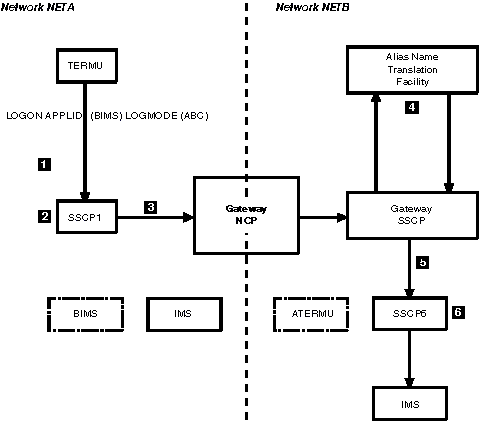 z/OS Communications Server: SNA Network Implementation Guide
z/OS Communications Server: SNA Network Implementation Guide
 z/OS Communications Server: SNA Network Implementation Guide
z/OS Communications Server: SNA Network Implementation Guide
|
Previous topic |
Next topic |
Contents |
Contact z/OS |
Library |
PDF
Defining alias names z/OS Communications Server: SNA Network Implementation Guide SC27-3672-01 |
|
|
When defining resources in interconnected networks, you must reconcile
any name conflicts among the connected networks. Following are the
ways you can do this:
The method that is best for you depends on how many names must be changed and how much control you have over the various networks. To use an alias name translation facility, define all the logical units in the interconnected networks that are not already defined and their owning SSCPs to the NetView® alias name translation facility and assign alias names. Then, if VTAM® does not have a complete definition of a destination logical unit for a session setup request, it invokes the NetView alias name translation facility with the name of the logical unit. The NetView alias name translation facility returns the name of the SSCP defined as the owner of the logical unit, and the destination network ID and the logical unit real name in that destination network. If the following conditions are true, the request for the session
is sent to the owning SSCP:
VTAM automatically creates a CDRSC definition for the logical unit. If you have not installed a name translation facility, or if the name translation facility does not return the name of the owning SSCP, SSCP selection using the adjacent SSCP table is tried next. Note: VTAM uses real names
and alias names when referencing an LU. An alias name is the name
of the LU as known in the network of its session partner. Because
one LU can be in session with partners in more than one network, an
LU can have multiple alias names. VTAM can obtain real and alias names through an alias translation
application program (for example, NetView). If such an application program or the alias function
of the session management exit routine is not in use, VTAM uses network qualifiers to define the real
and alias names for logical units, in which case, all resource names
must be unique. Therefore, no two LUs can have the same name, whether
they are in the same network. However, if you are using network-qualified
names, you can have duplicate resource names in different networks.
In general, when VTAM receives a session setup request and the alias name translation facility is active, VTAM invokes the alias name translation facility to translate LU names, Class of Service names, and the logon mode name. You can use the TRANSLAT start option to limit the scope of the translation functions for which VTAM invokes the NetView program. The default for the CDRDYN start option is YES, enabling dynamic CDRSC definition. The CDRDYN start option overrides the CDRDYN operand on the host CDRM definition statement. CDRDYN must be YES for the VTAM in which the NetView alias name translation facility or the alias function of the session management exit routine is used. If an alias name is defined to VTAM with a CDRSC definition (either predefined or dynamically defined), the DISPLAY operator command can be used to display the real name associated with that alias name (if a session exists with the resource and if VTAM has determined the real name). You should have a convention for creating alias names. This alias naming convention should identify a name as an alias name. An operator often needs to know whether a resource name is an alias name or a real name. For example, the NetView program requires that the operator enter the real name of a resource when a display is requested. Note: The generic name used by the alias function should not also
be used by USERVAR.
As an example of name translation, Figure 1 shows a gateway NCP connecting two networks, NETA and NETB. Both networks contain an application program named IMS™. A terminal user, TERMU, in NETA wants to log on to the IMS that is in NETB. Figure 1. Example of name translation
 The following steps show how name translation is used in setting up a session between TERMU in NETA and IMS in NETB. The numbers shown in Figure 1 correspond to the following steps.
After the session is set up, it appears to SSCP1 that TERMU is in session with a CDRSC in NETA named BIMS. To SSCP6, it appears that IMS is in session with a CDRSC in NETB called ATERMU. However, if SSCP1 or SSCP6 were a VTAM with the NETID start option specified, SSCP1 or SSCP6 would also be aware that this is a cross-network session. The rules for name translation are as follows:



|
 Copyright IBM Corporation 1990, 2014 Copyright IBM Corporation 1990, 2014 |